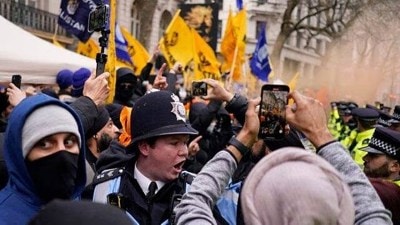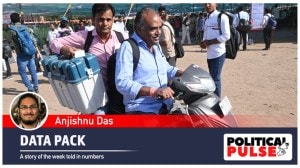- India
- International
A worm’s-eye view
The triple crises — the mismanagement of the economy, the spread of the pandemic and the confrontation with China — have exposed India’s weaknesses.
 Prime Minister Narendra Modi with ministers. (Express photo by Prem Nath Pandey)
Prime Minister Narendra Modi with ministers. (Express photo by Prem Nath Pandey)
A few days ago, Dr Manmohan Singh co-authored with Mr Praveen Chakravarthy (The Hindu, August 3, 2020) an essay on reviving the Indian economy. It contained three simple objectives: restoring confidence among people, restoring confidence among bankers, and restoring confidence among international organisations.
The prescription under each was detailed, but not beyond the comprehension and capacity of a caring, competent government.
Predictably, there has been no official reaction to the essay. Of course, one can ask ‘should the government react to every essay’? The answer is, no, but this was no ordinary essay. It was co-authored by Dr Singh, the author of India’s path-breaking economic reforms and a former finance minister (5 years) and former prime minister (10 years).
Be that as it may, are the Singh-Chakravarthy prescriptions valid? Each one of you may relate the ideas therein to the reality you see around you. I have tried to do that in my native Sivagangai district and neighbouring districts of Tamil Nadu. Here are the voices from the ground.
Among the People
Among the people, there is fear of spending. They don’t have enough money, many have lost their jobs or fear losing jobs, and what if someone falls ill and needs to be hospitalised? People are hoarding the little money they have. If some have large amounts of cash, they are putting it in gold (buying gold reflects uncertainty). Currency with the public was Rs 26,72,446 crore on July 31. Demand and Time deposits have grown 12.0 per cent and 10.5 per cent respectively in 12 months. The only places where the people are willing to spend are kirana stores, vegetable and fruit shops, and pharmacies. As a result, many retail outlets are without customers — clothing, footwear, furniture, toys, diners/restaurants, electronics etc.

The fear of infection is so pervasive that many people don’t visit doctors or hospitals. Many general practitioners have shut their clinics. Local vaids are in demand for kashayam. AYUSH is making a comeback.
How will demand revive in such circumstances? Hence, Dr Singh has reiterated the need for cash transfers to the people. India is perhaps the only large country that has shunned cash transfers, even while it is feared that millions of people just above the poverty line may slide into poverty.
Among Bankers (and Borrowers)
No one I have spoken to gives a tuppence for the exhortations of the finance minister. Bankers listen to the RBI that has warned that NPAs may rise to 14.7 per cent by March 2021. No banker will lend on the strength of the current balance sheets of potential borrowers. Look at the fate of the ‘Rs 3 lakh crore credit guarantee scheme’ announced amidst great fanfare. We were led to believe that the government will guarantee to the banks that it will pay up to Rs 3 lakh crore against loan defaults. We believed that the total lending can be up to Rs 30 lakh crore (assuming an NPA of 10 per cent). Apparently, we were wrong. Government has now hinted that it had promised only total loans up to Rs 3 lakh crore; of which Rs 1,36,000 crore have been sanctioned and Rs 87,227 crore have been disbursed! I am reminded of the Tamil proverb that the donkey has reduced itself to a black ant! Amidst little enthusiasm for lending and more fanfare, the scheme has been enlarged to lend to bigger businesses and self-employed professionals.
However, there is no confidence among borrowers. The Tiruppur garment industry is producing at 30 per cent of capacity. Job work units are working at 60 per cent of capacity. A hardware merchant, cement dealer or tyre dealer struggles with a turnover of 20 per cent of normal in order to keep his dealership. The potential borrower is worried he would not be able to repay the loan. If he has his own money, he ploughs it into the business; if not, he is content to operate at lower capacity.
Large businesses have publicly announced they will cut back capital expenditure and conserve cash. Renowned business houses have declared their intention to become debt-free. All this will tell on growth and job-creation.
Among International Organisations
The way the government has discredited free trade has created deep suspicion around the world. India speaks openly about breaking WTO rules and has positioned itself against multilateral and bilateral trade agreements. Import substitution is the new (old?) road to prosperity. Quantitative restrictions, high tariffs and non-tariff barriers are back. I call it the Trump effect, government calls it Atmanirbhar, no different from the autarchic policies followed between 1960 and 1990.
Take a count of the institutions that are a pale shadow of what they ought to be: Information Commission, Election Commission, Competition Commission, Niti Aayog (formerly Planning Commission), PM’s Economic Advisory Council, Office of Chief Economic Adviser, Office of Comptroller & Auditor General and more. The various Rights Commissions are in deep slumber, none more than the Human Rights Commission. Today, opinion about India among businesses, Institutional investors, Pension funds and Wealth funds is generally negative.
The triple crises — the mismanagement of the economy, the spread of the pandemic and the confrontation with China — have exposed India’s weaknesses. Dr Singh, a patriot to the core, and Mr Chakravarthy have shown a practical and feasible way to navigate India out of the economic crisis.
EXPRESS OPINION
More Explained
Apr 26: Latest News
- 01
- 02
- 03
- 04
- 05











































